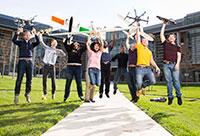Mechanical engineering is an evolving discipline that adapts to the current needs of society. At UC Merced, our mechanical engineers are focused on finding relevant solutions to real-world problems today.
For example, our Mechatronics, Embedded Systems and Automation (MESA) Lab is focused on finding non-military uses for unmanned aerial vehicles (UAVs). The UAVs can be programmed for specific autonomous missions, such as monitoring agricultural fields and detecting natural gas leaks along miles of pipeline.
“This is not a dream – it’s very possible,” said School of Engineering Professor YangQuan Chen, who runs the lab. “We are finding ways to bring technology to the people who need it.”
As one of the campus’s newest areas of research, the MESA lab is one more way UC Merced’s cutting-edge research will benefit society. Not just devoted to the area of drones, the lab also conducts research on cyber-physical systems, modeling and control of renewable energy systems, mechatronics and applied fractional calculus.
Sometimes, finding solutions requires thinking outside the box or, in the case of research, even thinking beyond discipline. That’s another area where UC Merced researchers excel. Take Professor Sachin Goyal, for instance. A mechanical engineer by trade, he was working on the problem of undersea cables that buckle and twist when he recognized similarities between those cables and DNA.
That realization led him to explore the world of biofilaments. When biofilaments twist, twine, bend or loop in the ways that are correct for them, the result is a normal, healthy organism, be it a cell, an organ or a whole body.
Now Goyal and graduate student Nitish Appanasamy are modeling the “deformation” of certain strands of DNA, trying to find ways to predict how such strands react when proteins, enzymes and outside forces are introduced to them.
The goal is to be able to design medications or medical treatments that will encourage biofilaments to deform in ways that cure diseases.
“In principal, it extends to any disease,” Goyal said. “It could work for injuries, too, because what that’s really about is tissue damage. Every disease, every injury involves DNA.”



